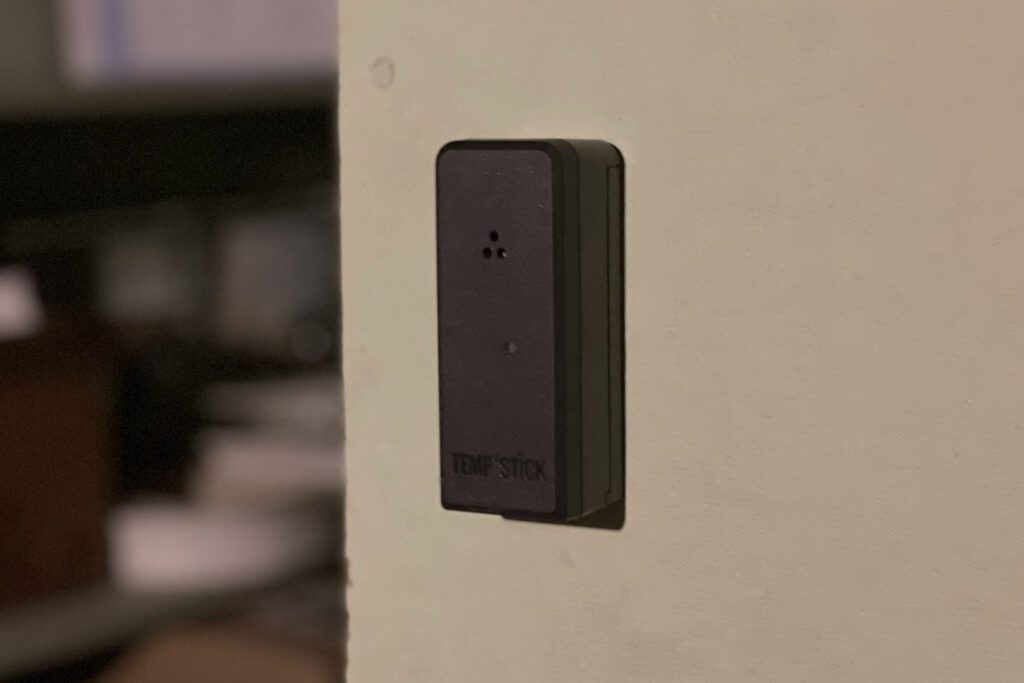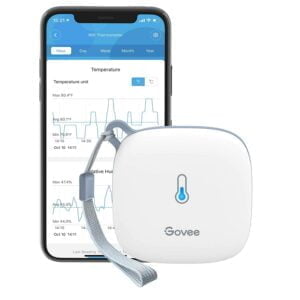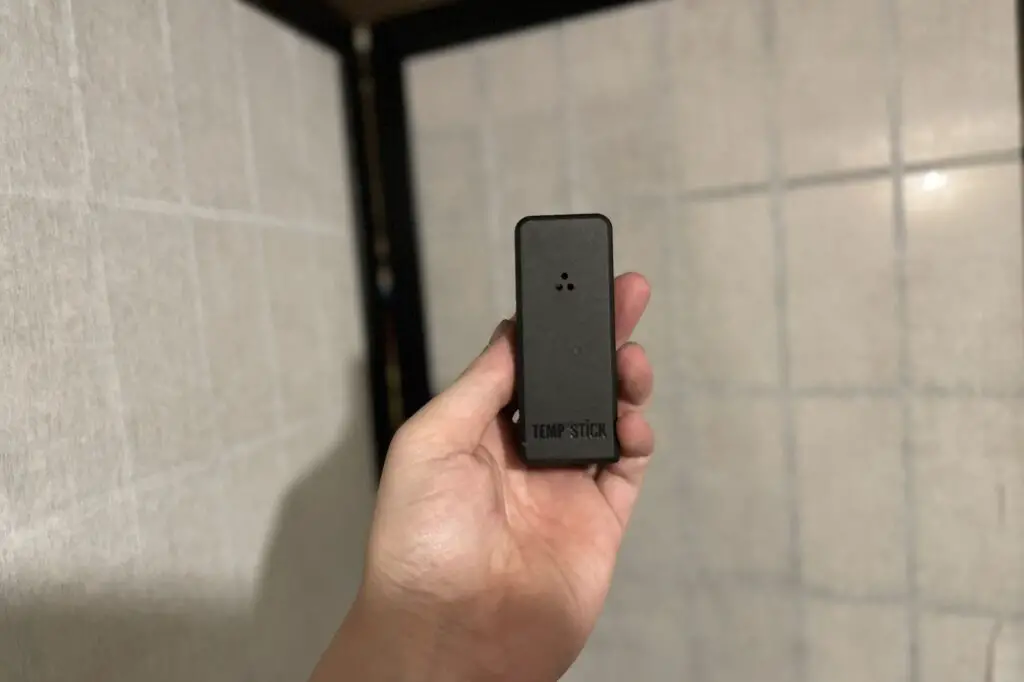Welcome to our WiFi temperature sensor buyers guide! If you’re looking for tips on what to look for and the results of our remote temperature sensor test, you’ve come to the right place. See our Best WiFi Temperature Sensors of 2023 rankings for our full reviews, which use the tests below to determine the “best” WiFi temperature sensor available. This page will be regularly updated as we test (and sometimes retest) new wifi temperature sensors.
WiFi Temperature Sensor Buyers Guide
If you’re in the market for a WiFi Temperature sensor, we recommend focusing on the following factors.
- Accuracy: Inaccurate sensors aren’t going to do you much good. We’ve selected the above primarily on this factor, but if you choose another, carefully look for reviews for accuracy issues.
- Data Storage: While accuracy is essential, you also want to recall past data to spot trends and make better decisions based on those trends. The Temp Stick and SensorPush are two of our top recommendations.
- Sensor Placement: Where do you plan to place the sensor? Some sensors are quite large and might not fit in tight spaces.
- Battery Life: Most battery-powered WiFi temperature sensors operate for an extended period. The last thing you want to be doing is replacing batteries often. We recommend buying a device that lasts anywhere from six months to a year on the same batteries.
- Expandability: Unless you’re sure you’ll need only one sensor, opt for WiFi temperature sensors that allow you to add additional sensors to your setup. You’ll thank us later.
- Cost: Last, be sure to factor cost into your buying decision. While the Temp Stick and SensorPush are highly accurate, they also are several times more expensive. It might be worth purchasing a slightly less accurate device so you’re not breaking the bank.
Our WiFi Temperature Sensor Test Results
Jump to: Full Rankings | Accuracy | Affordability | Durability | Feature Set | Ease of Use
10 WiFi temperature sensors were considered for our rankings for the Best WiFi Temperature Sensor of 2022. To determine the best model, we look at five areas: accuracy/performance, affordability, durability, feature set, and ease of use. We then compare them side by side, giving a rating in each area. The overall rating is weighted in the following manner:
- Accuracy/Performance: 25%
- Affordability: 25%
- Durability: 20%
- Feature set: 15%
- Ease of use/usability: 15%
To decide which WiFi temperature sensor is the best, we’ve developed a 100-point scoring system to determine the five best we will feature in our rankings. Below, we’ve ranked our top WiFi temperature sensors in each area. A device’s overall ranking breaks the tie where the scores are the same.
Generally, scores between 80-100 are considered the best, 70-80 good, 60-70 average, and 59 and below poor. Here are the scores for the home WiFi temperature sensors we tested.
Which WiFi temperature sensor is the best overall?
Our Pick: Temp Stick. We can’t say enough good things about the Temp Stick, and its score of 90 proves it — so far, the best score of any product we reviewed (not just WiFi temperature sensors). The accuracy is outstanding, and the Temp Stick can last for about a year on the same ‘AA’ batteries — even if it’s sending data every 15 minutes.
However, we’d be remiss not to speak highly of the SensorPush devices, all of which ranked in the next three spots. Our favorite is the HT1 for its low price and near-Temp Stick accuracy, although the HTP.xw is attractive as it adds pressure measurements and water resistance.
Temp Stick
Review Score: 90/100
Find the Best Deal Our ReviewSensorPush HT1
Review Score: 87/100
Find the Best DealSensorPush HTP.xw
Review Score: 84/100
Find the Best DealSensorPush HT.w
Review Score: 83/100
Find the Best DealGovee WiFi Thermometer Hygrometer
Review Score: 82/100
Find the Best DealMarCELL
Review Score: 77/100
Find the Best DealGovee WiFi Thermometer
Hygrometer 3 Pack
Review Score: 77/100
Find the Best Deal
Which WiFi temperature sensor is the most accurate?
Our Pick: Temp Stick. The Temp Stick impressed us throughout our test, especially with its long battery life and superior accuracy to every other WiFi temperature sensor we’ve had the chance to look at. However, any of the SensorPush wireless temperature sensing devices also perform very well, so you won’t go wrong choosing any of those, either.
The Govee WiFi temperature sensors are a case of “you get what you pay for.” Its error of +/- .5F isn’t bad. However, it’s not as good as the Temp Stick’s performance in this department.
Accuracy Ratings
Temp Stick
5/5
SensorPush HT1
4/5
SensorPush HTP.xw
4/5
SensorPush HT.w
4/5
Govee WiFi Thermometer Hygrometer
4/5
Govee WiFi Thermometer
Hygrometer 3 Pack
4/5
MarCELL
3/5
Which WiFi temperature sensor is the most affordable?
Our Pick: Govee WiFi Thermometer Hygrometer. Govee’s WiFi thermometer hygrometers are cheap and rank high in our ratings. However, if you spend just a little more, the SensorPush HT1 is much more accurate, with a battery life that will likely exceed the Govee. If you need water resistance, select the SensorPush HT.w instead.
Affordability Ratings
Govee WiFi Thermometer Hygrometer
5/5
SensorPush HT1
5/5
SensorPush HT.w
4/5
Govee WiFi Thermometer
Hygrometer 3 Pack
4/5
SensorPush HTP.xw
4/5
Temp Stick
3/5
MarCELL
3/5

Which WiFi temperature sensor is the most durable?
Our Pick: Temp Stick, any SensorPush, or MarCELL. For the most part, any WiFi temperature sensor you choose from our rankings will be durable. We found the construction of the Temp Stick, SensorPush, and MarCELL to be the most durable. Generally, as you decrease in price, the overall durability drops.
Durability Ratings
Temp Stick
5/5
SensorPush HT1
5/5
SensorPush HTP.xw
5/5
SensorPush HT.w
5/5
MarCELL
5/5
Govee WiFi Thermometer
Hygrometer
4/5
Govee WiFi Thermometer
Hygrometer 3 Pack
3/5
4/5
Which WiFi temperature sensor has the most features?
Our Pick: Temp Stick or MarCELL. The Temp Stick has built-in WiFi, and the MarCELL has built-in cellular data service through Verizon, although you pay $8.50/month for the service, so we’d give the Temp Stick ever so slightly the edge here, thanks to no additional fees. The SensorPush devices also score well here, but you need a WiFi gateway to connect to the internet, which costs them in our tests.
Both Govee models scored low here, as the WiFi only works when your mobile device is on the same network. They’re also much more basic than the Temp Stick or MarCELL, which explains the price difference.
Functionality Ratings
Temp Stick
5/5
MarCELL
5/5
SensorPush HTP.xw
4.5/5
SensorPush HT.w
4/5
SensorPush HT1
3.5/5
Govee WiFi Thermometer
Hygrometer 3 Pack
3.5/5
Govee WiFi Thermometer
Hygrometer 3 Pack
3.5/5

Which WiFi temperature sensor is the easiest to use?
Our Pick: Temp Stick. While the Temp Stick is a fully featured WiFi temperature sensor, it doesn’t add extra functionality at the cost of making the device overall harder to use. But SensorPush has done an excellent job making their WiFi thermometers very user-friendly, so they rank high in our ratings for usability.
Usability Ratings
Temp Stick
5/5
SensorPush HT1
4/5
SensorPush HTP.xw
4/5
SensorPush HT.w
4/5
Govee WiFi Thermometer Hygrometer
4/5
Govee WiFi Thermometer
Hygrometer 3 Pack
4/5
MarCELL
4/5


